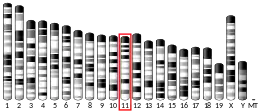Glucagon-like peptide-2 receptor
Glucagon-like peptide-2 receptor (GLP-2R) is a protein that in human is encoded by the GLP2R gene located on chromosome 17.[5]
Function
The GLP2 receptor (GLP2R) is a G protein-coupled receptor superfamily member closely related to the glucagon receptor (GLP1 receptor). Glucagon-like peptide-2 (GLP2) is a 33-amino acid proglucagon-derived peptide produced by intestinal enteroendocrine cells. Like glucagon-like peptide-1 (GLP1) and glucagon itself, it is derived from the proglucagon peptide encoded by the GCG gene. GLP2 stimulates intestinal growth and upregulates villus height in the small intestine, concomitant with increased crypt cell proliferation and decreased enterocyte apoptosis. Moreover, GLP2 prevents intestinal hypoplasia resulting from total parenteral nutrition. GLP2R, a G protein-coupled receptor superfamily member is expressed in the gut and closely related to the glucagon receptor (GCGR) and the receptor for GLP1 (GLP1R).[6]
See also
References
- GRCh38: Ensembl release 89: ENSG00000065325 - Ensembl, May 2017
- GRCm38: Ensembl release 89: ENSMUSG00000049928 - Ensembl, May 2017
- "Human PubMed Reference:". National Center for Biotechnology Information, U.S. National Library of Medicine.
- "Mouse PubMed Reference:". National Center for Biotechnology Information, U.S. National Library of Medicine.
- Brubaker PL, Drucker DJ (2002). "Structure-function of the glucagon receptor family of G protein-coupled receptors: the glucagon, GIP, GLP-1, and GLP-2 receptors". Receptors & Channels. 8 (3–4): 179–88. doi:10.1080/10606820213687. PMID 12529935.
- "Entrez Gene: Glucagon-like peptide 2 receptor".
Further reading
- Burrin DG, Petersen Y, Stoll B, Sangild P (Mar 2001). "Glucagon-like peptide 2: a nutrient-responsive gut growth factor". The Journal of Nutrition. 131 (3): 709–12. doi:10.1093/jn/131.3.709. PMID 11238747.
- Munroe DG, Gupta AK, Kooshesh F, Vyas TB, Rizkalla G, Wang H, Demchyshyn L, Yang ZJ, Kamboj RK, Chen H, McCallum K, Sumner-Smith M, Drucker DJ, Crivici A (Feb 1999). "Prototypic G protein-coupled receptor for the intestinotrophic factor glucagon-like peptide 2". Proceedings of the National Academy of Sciences of the United States of America. 96 (4): 1569–73. doi:10.1073/pnas.96.4.1569. PMC 15520. PMID 9990065.
- Yusta B, Huang L, Munroe D, Wolff G, Fantaske R, Sharma S, Demchyshyn L, Asa SL, Drucker DJ (Sep 2000). "Enteroendocrine localization of GLP-2 receptor expression in humans and rodents". Gastroenterology. 119 (3): 744–55. doi:10.1053/gast.2000.16489. PMID 10982769.
- Thulesen J, Knudsen LB, Hartmann B, Hastrup S, Kissow H, Jeppesen PB, Ørskov C, Holst JJ, Poulsen SS (Jan 2002). "The truncated metabolite GLP-2 (3-33) interacts with the GLP-2 receptor as a partial agonist". Regulatory Peptides. 103 (1): 9–15. doi:10.1016/S0167-0115(01)00316-0. PMID 11738243. S2CID 23179465.
- Koehler JA, Yusta B, Drucker DJ (Feb 2005). "The HeLa cell glucagon-like peptide-2 receptor is coupled to regulation of apoptosis and ERK1/2 activation through divergent signaling pathways". Molecular Endocrinology (Baltimore, Md.). 19 (2): 459–73. doi:10.1210/me.2004-0196. PMID 15471943.
- Ørskov C, Hartmann B, Poulsen SS, Thulesen J, Hare KJ, Holst JJ (Jan 2005). "GLP-2 stimulates colonic growth via KGF, released by subepithelial myofibroblasts with GLP-2 receptors". Regulatory Peptides. 124 (1–3): 105–12. doi:10.1016/j.regpep.2004.07.009. PMID 15544847. S2CID 6613593.
- Mahon MJ, Shimada M (Jan 2005). "Calmodulin interacts with the cytoplasmic tails of the parathyroid hormone 1 receptor and a sub-set of class b G-protein coupled receptors". FEBS Letters. 579 (3): 803–7. doi:10.1016/j.febslet.2004.12.056. PMID 15670850. S2CID 6471940.
- Estall JL, Koehler JA, Yusta B, Drucker DJ (Jun 2005). "The glucagon-like peptide-2 receptor C terminus modulates beta-arrestin-2 association but is dispensable for ligand-induced desensitization, endocytosis, and G-protein-dependent effector activation". The Journal of Biological Chemistry. 280 (23): 22124–34. doi:10.1074/jbc.M500078200. PMID 15817468.
- Guan X, Karpen HE, Stephens J, Bukowski JT, Niu S, Zhang G, Stoll B, Finegold MJ, Holst JJ, Hadsell D, Hadsell DL, Nichols BL, Burrin DG (Jan 2006). "GLP-2 receptor localizes to enteric neurons and endocrine cells expressing vasoactive peptides and mediates increased blood flow". Gastroenterology. 130 (1): 150–64. doi:10.1053/j.gastro.2005.11.005. PMID 16401478.
- Sams A, Hastrup S, Andersen M, Thim L (Feb 2006). "Naturally occurring glucagon-like peptide-2 (GLP-2) receptors in human intestinal cell lines". European Journal of Pharmacology. 532 (1–2): 18–23. doi:10.1016/j.ejphar.2005.12.001. PMID 16448646.
- "Glucagon Receptor Family: GLP-2". IUPHAR Database of Receptors and Ion Channels. International Union of Basic and Clinical Pharmacology.
External links
- Glucagon-Like Peptide-2 Receptor at the US National Library of Medicine Medical Subject Headings (MeSH)
This article incorporates text from the United States National Library of Medicine, which is in the public domain.




